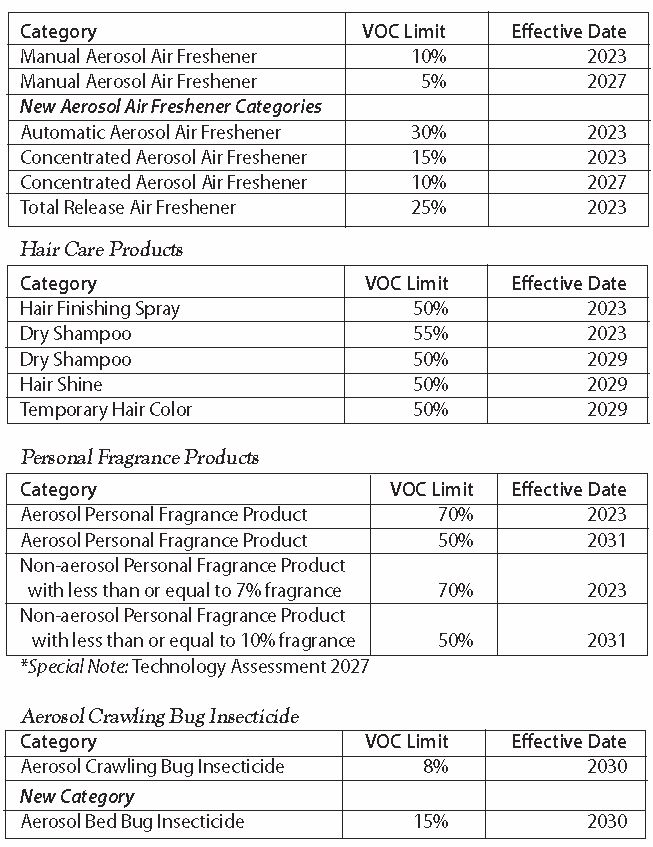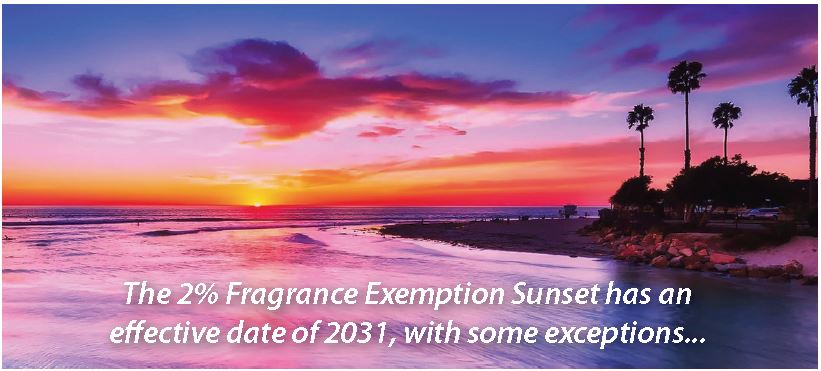Written on: May 1, 2021 by Doug Raymond
California Air Resources Board
On March 25, 2021, the California Air Resources Board (CARB) held a public hearing to adopt amendments to its Consumer Products volatile organic compound (VOC) regulations.
To review, CARB began regulating Consumer Products in the late 1980s, starting with Antiperspirants/Deodorants. Since then, more than 150 product categories have been regulated with a 50% reduction in VOCs from Consumer Products.

This current rulemaking started with a three-year survey from 2013–2015 with 491 consumer product categories reviewed, surveying more than one million products from 1,500 product manufacturers. This was the largest survey undertaking on consumer products ever. The years 2016–2018 were then spent processing and reviewing survey data. The Rule Development Process began in 2019 and included 22 workgroup meetings, five public workshops, as well as numerous meetings with manufacturers/formulators/trade groups/non-government organizations (NGOs) and interested stakeholders. Thus, after nearly two years of meetings, the following amendments were worked out between CARB and the Industry.
Air Fresheners
Single and Double-phase Aerosol Air Freshener categories were combined into one new product category called Manual Aerosol Air Freshener. Below are the new product categories, VOC limits and effective dates.


Fragrance Exemption Sunset
The 2% Fragrance Exemption Sunset has an effective date of 2031. Exceptions include:
• 0.25% monoterpene exemption allowed in non-aerosol General Purpose Cleaners/Degreasers in 2023
• 0.25% VOC exemption allowed for Air Fresheners, Disinfectants and Sanitizers in 2031
VOC Reductions
CARB needed to obtain 1–2 tons per day (tpd) of VOC emissions in the South Coast area by 2023. The VOC limits for 2023 shown on the previous page get 1.25 tpd in the South Coast and 3.00 tpd Statewide. CARB was also required to achieve a total of 4–5 tpd in the South Coast and 8-10 tpd Statewide by 2031. The VOC limits for 2031 shown on the previous page achieve a VOC reduction of 4.03 in the South Coast and 9.80 tpd Statewide by 2031. Thus, CARB fulfills the State Implementation Plan (SIP) commitments if all of the VOC limits for the product categories are met.
The big question is whether Personal Fragrance products can meet the 2031 VOC limits. If not, CARB will need to look elsewhere, meaning it may target other VOC categories for more emission reductions.
Other Amendments
The following amendments passed:
• Definition change for Energized Electrical Cleaner
• Prohibition of perchloroethylene, trichloroethylene, methylene chloride and parachlorobenzotrifluoride (PCBTF) in the above seven categories. This is to prevent these compounds from being used. These compounds are not used now in these categories
• Prohibition on substances with a Global Warming Potential (GWP) higher than 150. This does not affect the use of HFC- 152a
• Addition of diethyl carbonate, 1-chloro-3,3,3-trifluoropropane, HFO-1233zd and alkane mixed-minimally 90% C13 and higher to the maximum incremental reactivity (MIR) Table of Values
• Updates to Test Method 310
• Updates to Alternative Control Plan and Innovative Product Exemption (IPE)
Innovative Product Exemption
Another issue that arose during the hearing was the new IPE provision for compressed gases and the proposed IPE provision for reactivity. The Board directed staff to work on these issues, as well as on a possible exemption for HFO-1233zd.
Hearing Summary
All considered, the hearing went as expected with no real surprises. Once public comments were concluded, the Board directed the Executive Officer to determine if additional conforming modifications to the regulations were appropriate and to make any proposed modifications (along with supporting documentation) available for public comment for 15 days. This 15-day period is mandated under Government Code Section 11346.8(c). CARB must consider any written comments received during the 15-day period, respond to them in the Final Statement of Reasons and make any additional changes, as appropriate. If a change is substantial, but not sufficiently related to the original proposal (i.e. not reasonably foreseeable based on the notice of proposed action), the agency must then start another 45-day comment period.
 However, another 45-day comment period is unlikely. CARB will likely make all changes in a 15-day comment period. Be aware that it may take 60–90 days for the 15-day comment period to begin.
However, another 45-day comment period is unlikely. CARB will likely make all changes in a 15-day comment period. Be aware that it may take 60–90 days for the 15-day comment period to begin.
Outcome
After two years of work, Industry has VOC limits that it can hopefully live with. The
exception might be the 50% limit for Personal Fragrance products. The CARB Board instructed staff to work on the IPE for Compressed Gas, which is good. The resolutions instruct staff to work on the exemption for the HFO-1233zd, which could lead to another tool for Industry to use to reduce VOCs. Finally, there was a resolution to have CARB staff continue to work on reactivity for use with Consumer Products. SPRAY